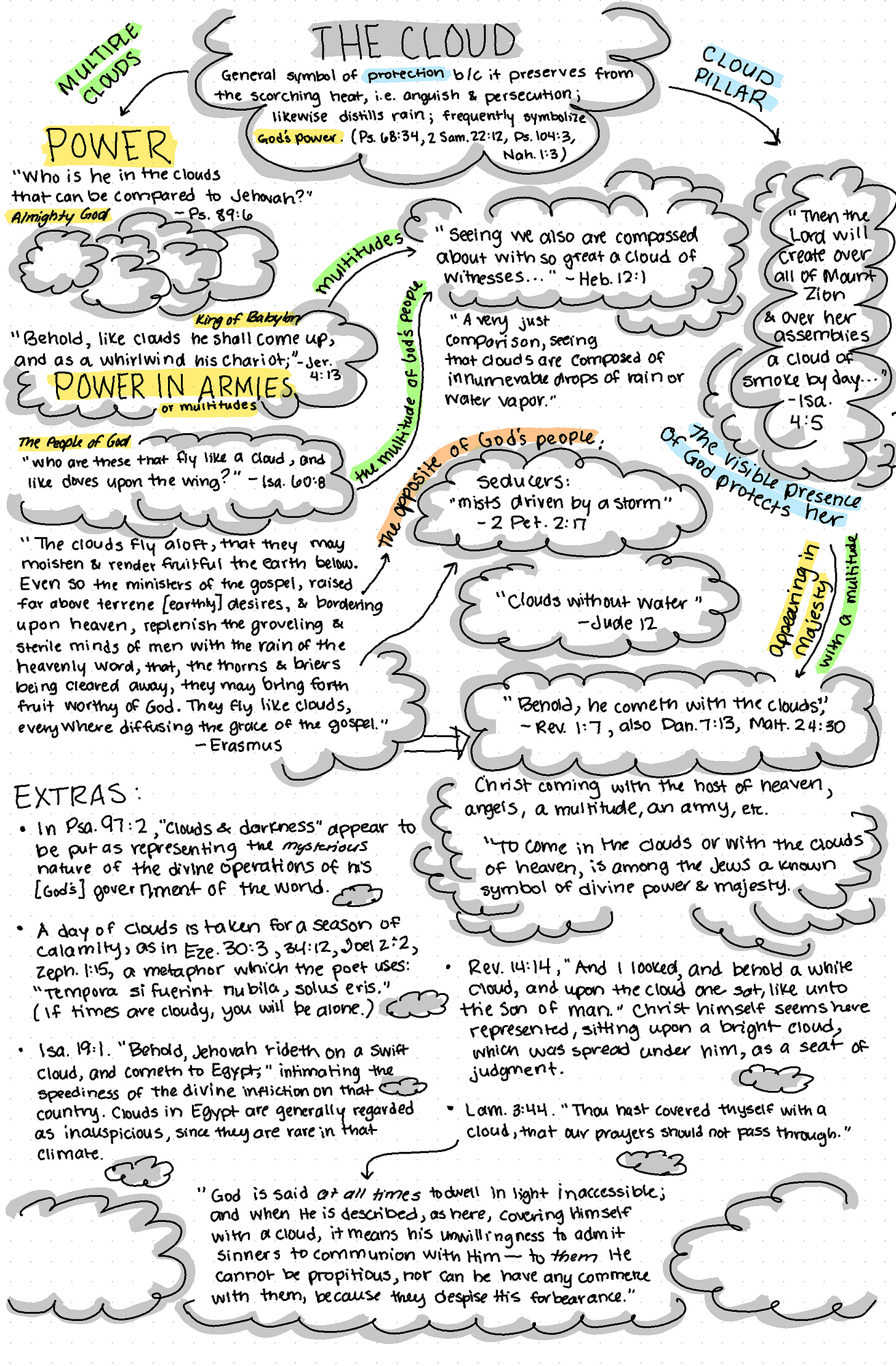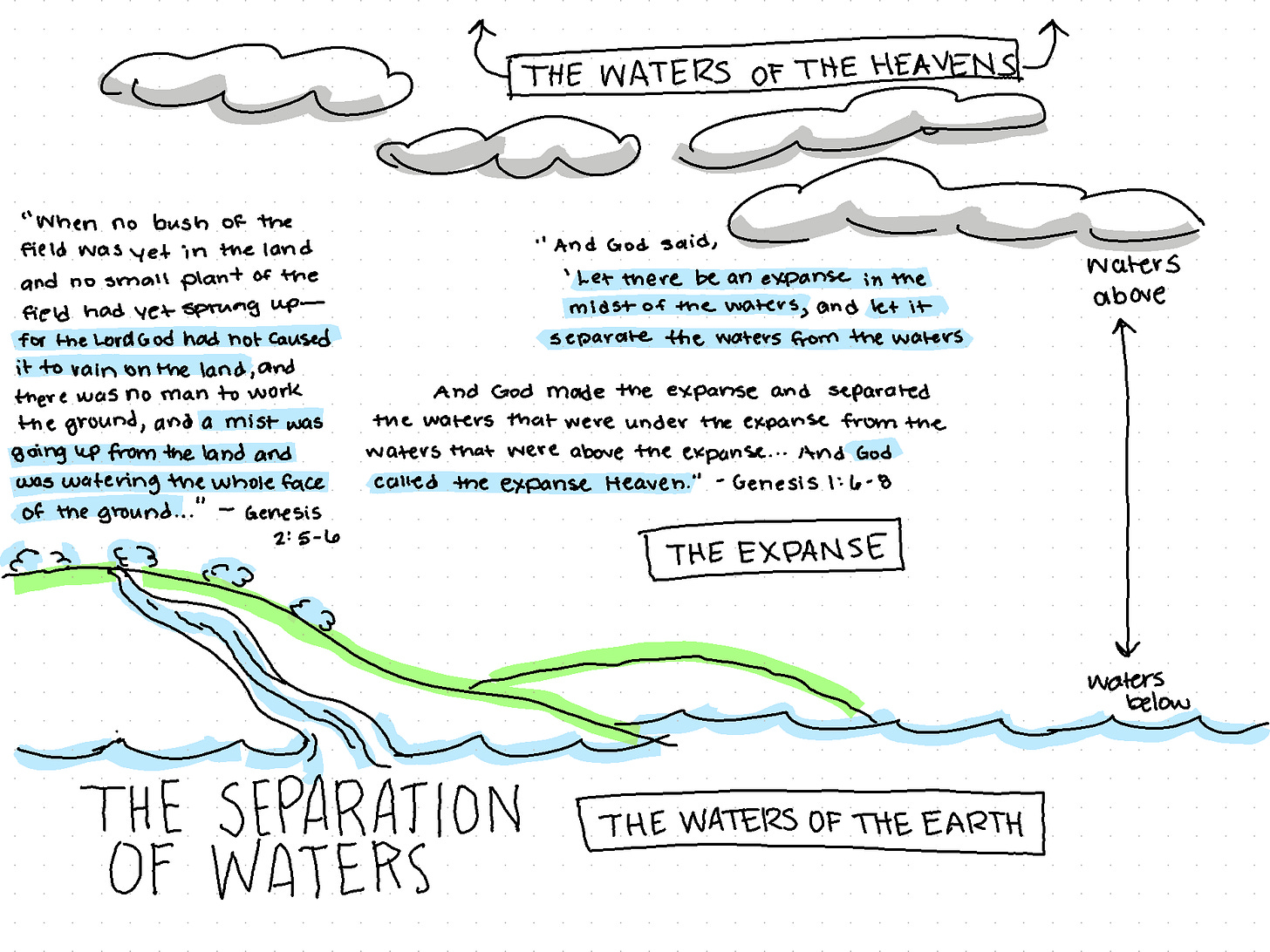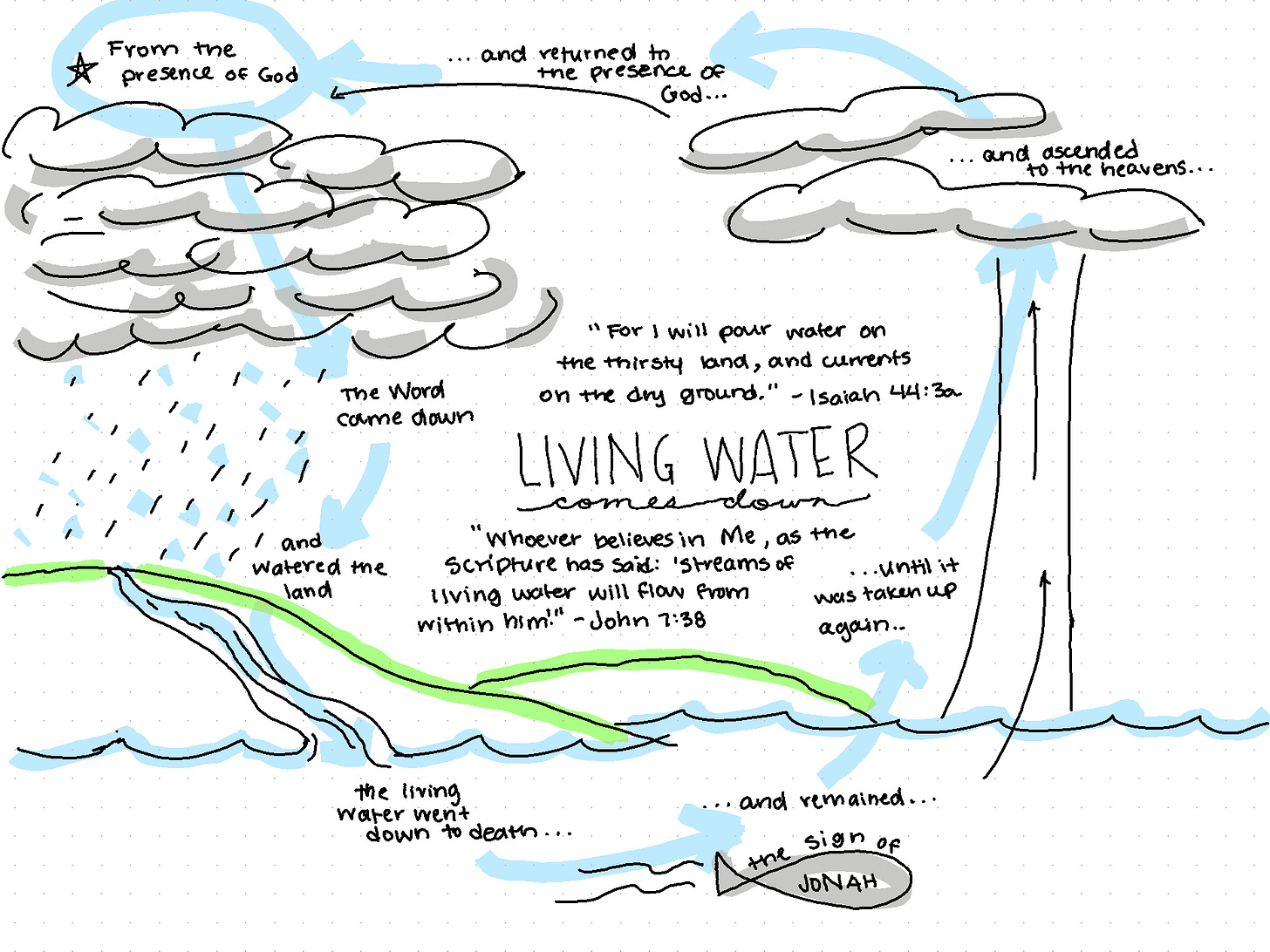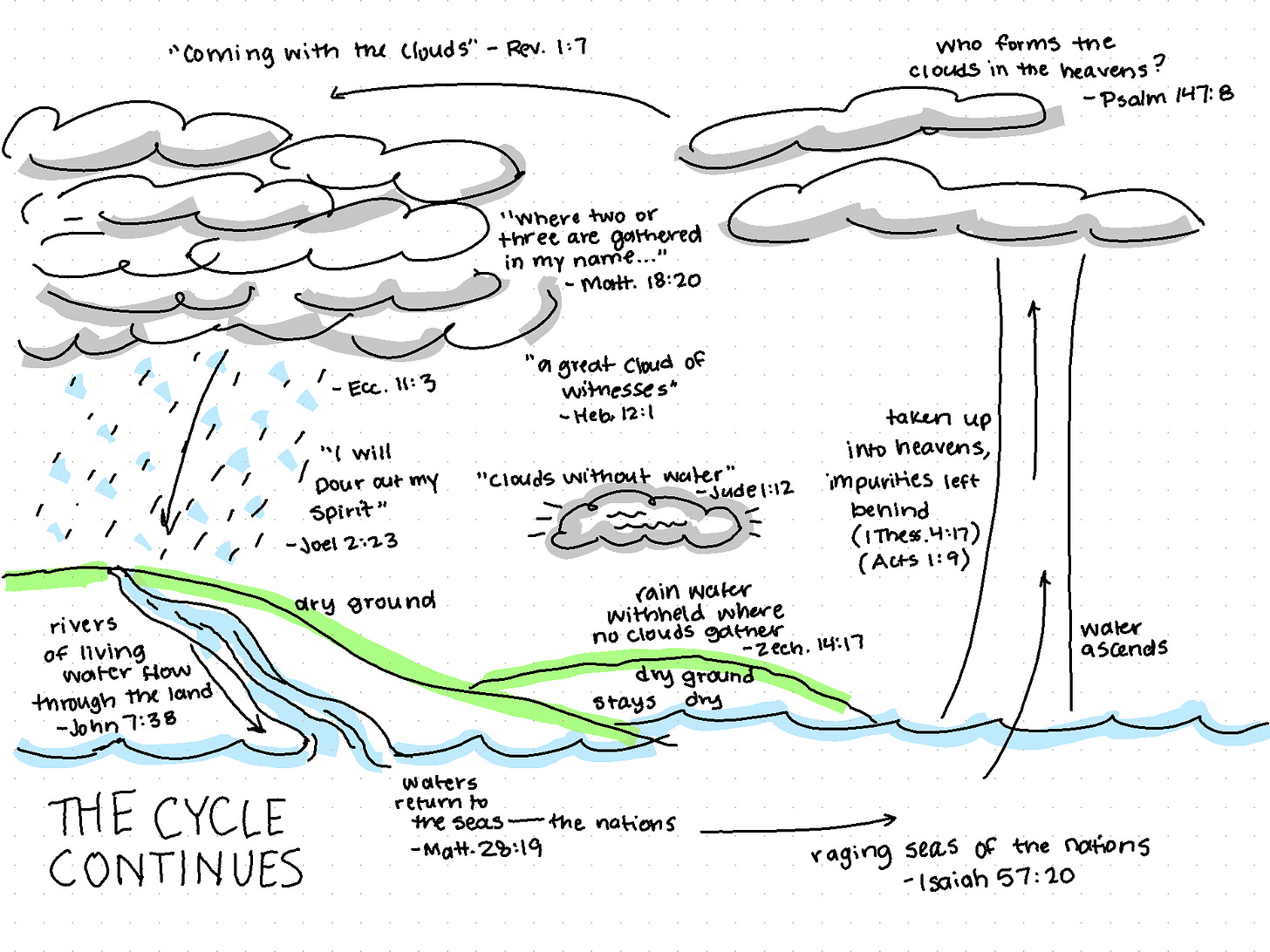“And God said, ‘This is the sign of the covenant that I make between me and you and every living creature that is with you, for all future generations: I have set my bow in the cloud, and it shall be a sign of the covenant between me and the earth. When I bring clouds over the earth and the bow is seen in the clouds, I will remember my covenant that is between me and you and every living creature of all flesh. And the waters shall never again become a flood to destroy all flesh. When the bow is in the clouds, I will see it and remember the everlasting covenant between God and every living creature of all flesh that is on the earth.’ God said to Noah, ‘This is the sign of the covenant that I have established between me and all flesh that is on the earth.’” - Genesis 9:12-17
If you’ve spent any time studying the symbolic language of scripture, you’ll know that the story of Noah is loaded with types and shadows. There’s theological significance to God shutting the door, to the ark itself, to the numbers associated with the story, to the rainbow, and many other things. But today I want to focus on an element that doesn’t get a lot of attention in the mainstream: clouds.
The conclusion of the flood story is the first time clouds are ever mentioned in scripture, and there is significance to that. Like all created things, there is an ancient precedent for cloud symbolism. Clouds show up in many different contexts throughout scripture and the final book of the canon is no exception. In Revelation 1:7 (the verse we are exegeting today), we read:
“Behold, he is coming with the clouds, and every eye will see him, even those who pierced him, and all tribes of the earth will wail on account of him. Even so. Amen.” - Revelation 1:7
What is the meaning of the clouds in scripture? And what does their meaning mean for us?
There are a couple of concepts we have to explain to lay the groundwork for interpreting this:
A spiritual reality
A corresponding physical symbol
After defining these separately, we will synthesize the two into a complete picture, which I think you’ll find very compelling.
Here is the first concept.
The Spiritual Reality of God Coming in Judgment
In a previous article—A Commentary on Isaiah 2, Pt. 1—I talked about the repeating pattern of God coming first with instruction and returning again to judge. Let’s revisit that here:
“We speak of the coming of Christ as occurring in two bodily advents. The first time he appeared in the flesh was 2,000 years ago to live a life of obedience, die by crucifixion, resurrect from the grave and ascend to the Father. The second time will be when he comes to judge the world at the end of the age. This second coming is referred to most often in scripture as “The Day of the Lord.”
This is true, but there’s actually a repeating pattern here:
God comes in grace. He delivers his word of instruction and warning to a particular people or person.
God appears a second time to judge whether that people or person heeded his word.
This is something that happens over and over again both in scripture, historically, and even in modern times. It does not mean that God appears in the flesh every time he dispenses his word or comes to judge its hearers. Here are some examples of this pattern:
God came first to Adam with instructions not to eat from the tree; God returned in judgment to find that Adam had disobeyed and threw him out of the garden.
God came first with a warning through the preaching of Noah; God returned in judgment with a flood that destroyed the wicked.
God came first to Nineveh with a warning to repent; God returned in judgment to find that they had repented and relented from destroying it.
God comes first to a man through the preaching of the word; God will return in judgment to each man to see whether he has heeded the message of the gospel.
Just the same, Christ came as the living Word of God to the Jews. When they rejected him, God “returned in judgment” in the year 70 AD. The temple and the nation were destroyed… When we speak of Christ’s first and second bodily advents, we are referring to the most comprehensive instance of God coming with his word and then returning in judgment. But, make no mistake, this visitation of first the word of God followed by the judgment of God is happening continually through history. Any time and anywhere the gospel is presented, God tarries until he returns to judge—both nations and individuals.”
The first thing we have to understand is that God is constantly dispensing his instruction or his word—in the modern era that is strictly through the testimony of the apostles—and then returning at some point to pass judgment on the hearers. We have to get outside the box of thinking that God came one time to bear witness (through Christ) and then took his hands off until the end of time. He did do this physically, but God is intimately involved in his creation. There is a real sense in which Christ is reigning over the earth right now and making judgments from his throne. As he said to his disciples before his ascension:
“‘All authority in heaven and on earth has been given to me.’” - Matthew 28:18b
Do we imagine Christ standing by waiting for a latter time he can officially begin his kingship (i.e. a literal kingdom on earth)? Or do we believe he is actively exercising his authority and power over the earth?
Hold on to all of that for a moment; here is the second concept.
The Physical Picture of the Cloud(s)
In scripture, the cloud primarily represents presence, power, and protection.—first and foremost relating to God’s presence, power, and protection. Then there are secondary applications relating to mankind. I’ve illustrated below the interpretations of the cloud(s), which I’ve taken from an antique biblical symbol dictionary. You can find the full text I am quoting from in the footnote.1
The compounding implications of cloud symbolism
(Key words: Power - yellow; Multitudes - green; Presence - blue.)
If you combine the three main things that the cloud signifies—power, presence, and multitudes (when they are gathered)—you begin to see what is being expressed in Revelation 1:7: “Behold, he is coming with the clouds.” Behold, he is (a) coming visibly, behold, he is (b) coming in power, behold, he is (c) coming with multitudes.
A final literal return + ongoing spiritual returns
Christ will one day finally appear in a literal sense. However, in the mean time, and as we’ve just illustrated above, scripture too frequently uses this language in other contexts to conclude that it is only referring to Christ’s final literal appearance. Thus, we can understand that God comes in another sense at other times. (See concept #1.)
Before Christ’s first advent, in the Old Testament, God came in judgment to nations repeatedly, including Israel. This was almost always in the form of armies, which destroyed and/or displaced the people under judgment. In the kingdom established at Christ’s first advent, he also comes to judge on an ongoing basis. This is symbolized by his coming on or with the clouds. Does he appear literally? Not for the time being, but his divine reign and judgment—expressed in his presence and his power, as delivered via a multitude—are felt by those under it. How? you might say.
Let’s combine the spiritual reality with the physical symbol.
Synthesizing the Spiritual Reality and the Physical Picture
The water is the Word of God dispensed/made manifest
Remember that the first time we read about rain or clouds in scripture is in the story of Noah. And neither are included in the description of creation. We only read that God had not caused it to rain on the earth and that, instead, a mist watered the ground. Do you know why?
At the time of creation, everything was already… how should we say this… imbued with life. The earth was spiritually nourished, it was complete, because the presence of God was there. As Erasmus said, the rain is what renders the earth fruitful. Yet there was no need for rain in the beginning because the earth flourished with God’s presence. The water was already present in the ground and appeared in a mist, which is a type of cloud, making it continuously bountiful. In the same way, God was already present with mankind, making him spiritually bountiful. There was no need for him to dispense his word in order to make the earth either physically or spiritually fruitful. This is why we don’t read about rain or clouds in the sky, but we do read about the vapors contained in the earth. It’s to illustrate to us the spiritual condition of mankind at that time.
The water is cut off physically & spiritually
But all that changed with the fall. Then the ground became cursed, the earth was no longer bountiful and required hard work to cultivate it. What spiritual condition did this negative development illustrate for us? That mankind was cut off from the presence of God.
Did it actually rain before the flood? We don’t know, but it doesn’t really matter. The scriptural narrative is what matters. Because the image being presented is that in the beginning, God dwelled with man—man was connected to the life-giver, the nourishing water was part of the earth. But when man was cut off from God, a new dynamic became necessary. From then on, water from the heavens would be required for the earth to produce anything beneficial. And the water of the word of God in heaven would be required for mankind to produce anything spiritually beneficial on the earth.
God sends rain upon the earth
The Former Rain
If we fast forward to the first advent of Christ, we can see an astonishing picture tucked into the fabric of the created order. The Bible speaks of the “former” and “latter” rains. Or, the rains of the autumn, which prepare the earth, and the rains of the spring, which invigorate the earth right before the summer harvest. (I encourage you to read my 3-part series The Biblical Feasts if you want to know more about how the seasons exemplify the first and second advents of Christ and how the arc of redemptive history moves in seasons.)
In the Old Testament, God caused it to rain or he withheld rain depending on Israel’s faithfulness to the covenant. This was a physical picture of THE former rain that God would send because of one man’s faithfulness to the covenant. And who was that man but Christ? For this reason, he is The Living Water (John 4) that God sent upon the earth to cause it to flourish. Christ is the former rain. Below, I have shown how I think the water cycle illustrates this:
Life
(Beginning at the star:) From the realm of the clouds, the heavens, where God dwells, the Word came raining down upon the earth. Everywhere he went, he watered the land; he brought life by exercising dominion, multiplying, transfiguring, healing, forgiving sin, casting out demons, etc.
Death
At the appointed time, that flow of life-giving water—the result of being in direct connection with the Father—was cut off at the crucifixion. (And I think there is significance to the fact that blood and water flowed from the side of Christ when he was speared, though I haven’t studied this enough to include it as an official part of this illustration.) The Living Water flowed down to the realm of the dead, which the sea symbolizes. And stayed there for 3 days to fulfill the sign of Jonah (whose own trip to the realm of the dead was a prophecy of Christ).
Resurrection
He was then raised again and ascended back into the heavens (in fact, hidden by a cloud at his ascension) into the presence of the Father.
The Latter Rain
But the water cycle is a cycle and we know Christ only came once in the flesh, not repeatedly. But in order for this illustration to work, there must be some continuance. That continuance is the Holy Spirit! At Pentecost, Peter stood up and quoted the prophet Joel, saying, “In the last days, God says, I will pour out My Spirit on all people” (Acts 2:17a). Christ, in former rain fashion, ministered on the earth to the nation of Israel in preparation for the giving of the Holy Spirit, which was the latter rain poured out over the whole earth so that an abundant harvest could be reaped for the kingdom.
The Cycle Continues
Christ, being the firstborn of all creation (Col. 1:15), set in motion what the Holy Spirit now empowers his bride to do in his name. For, as we’ve already said several times in this series, she is one with him. The church is now the dispenser of the word of God, we are the rain sent upon the earth. We R-E-I-G-N with him. WE R-A-I-N WITH HIM! This is the cycle of God dispensing his word and returning to judge over and over and over again.
The presence of the Holy Spirit in God’s people causes the church to flourish and this flows out to the realm of the dead, that is, the seas of the unconverted nations (Matt. 28:19, Isa. 57:20). From that raging dead sea, new drops of water are converted from death to life (salt water, you can’t drink it!). Or, you could say, the impurities that render the water dead (as opposed to life-giving) are left behind (or washed away). The fresh water vapor ascends and clouds are formed between the earth (the dwelling place of man) and the heavens (the dwelling place of God). That is to say, the Christian dwells with one foot in the world, and one foot in the kingdom of Christ, suspended between heaven and earth. These new clouds gather, forming a new source of rain, and the cycle continues.
Coming with the Clouds
So what does all this mean for us? Remember the cloud symbolizes the presence, the clouds symbolize the power, and the clouds express the power of God in multitudes.
In Christ, we are the ones with whom God’s presence dwells. He no longer rests in a pillar over an earthly tabernacle, but dwells in us by the Holy Spirit. We are the ones who reign in power with Christ. It is through us that God sends (or withholds) the life-giving water of his Word upon the earth. And, as God promised Abraham his offspring would be, so we are multitudes—as numerous the sands of the shore, as the stars in the sky or, if you will, as the drops of water in the clouds.
And when the clouds gather, Christ comes with them.
By their gathering we see Christ’s presence in his church, “Who are these that fly like a cloud?” Who are these that turn the dry and dead earth into a place imbued with life?
By their gathering we see Christ’s power, his power unto salvation! As it is the church which reigns with him as kings of the earth, turning the hearts of men, ironically, by pouring themselves out as living sacrifices (see The Book of Revelation, pt. 6).
And it is not with one cloud that God executes his purpose, but the clouds gather in multitudes to send the rains of his word on the earth.
We have been tasked with exercising spiritual dominion in his name and multiplying and ruling with Christ. Wherever we go, Christ goes with us. And much to the dismay of earthly kings, wherever we go, we bring the good news and, consequently, the judgment of God. (This will be critically important to remember the further we get into the book of Revelation!)
“Or do you not know that the saints will judge the world? And if the world is to be judged by you, are you incompetent to try trivial cases?” - 1 Cor. 6:2
The Judgment of Water
So what about Noah? What about that first mention of the clouds? We just kind of threw that out there and left it hanging.
You see, when God flooded the whole earth, he cleansed it completely. Keep in mind everything we’ve just discussed about water and the clouds. God opened the floodgates of heaven and the fountains of the deep and, by this action, he symbolically did not hold back his presence, his power, or the multitude of water at his disposal. The earth was cleansed by the sheer magnitude of God—nothing survived. Because sinful man cannot abide the unrelenting presence and power of God, not even for a moment. The only creatures that did survive were tucked in the ark, which, as you probably know, was a picture of Christ. That’s the only way any of us will survive in the presence of an all-powerful God.
In this instance, God unleashing himself on mankind did not give life—God’s power and presence depicted in the multitude of water was the judgment. It destroyed everything. God promised never to do that again. For our sake, God has veiled himself in the clouds, so that we may not all be destroyed (Exo. 33:20). Instead, he portions out the rain.
But make no mistake, as much as the rain he sends brings life, it still brings with it an element of destruction. God has a bow, a tool of war, but he hung it in the clouds until the appointed time. This signified that God has suspended his final judgment on the whole earth until one future day—then it will be destroyed by fire (2 Pet. 3:6-7). Until then, the rains come bringing life and death: when he sent Christ and, subsequently, the Holy Spirit, God sent the rains necessary to cleanse us from sin without destroying all flesh. Instead, he is continually destroying our flesh, one man and one idol at a time.
God’s bow may still be seen in the clouds, but it has been handed to Christ, and with the clouds, he comes swiftly. Whether you resist his reign/rain and remain dry and hard to his word, or you welcome the life he freely gives, every knee will bow, in heaven and on earth and under the earth, and every tongue will confess that Jesus Christ is Lord, to the glory of God the Father (Phil. 2:10-11).
He comes first in grace, then he comes in judgment. Some will receive him and some will wail at his coming. But, in the end, the clouds will part and all will see.
“Even so. Amen.”
“A cloud, without any token, showing it to be like a storm, always denotes what is good, and implies success.
It is in general the symbol of protection, because it preserves from the scorching heat of the sun, i.e. anguish and persecution; and as it likewise distills a rain or cool and benign influence…
In the holy writers, the clouds are frequently the symbols of God’s power. Thus, Ps. 68:34, ‘His strength is in the clouds,’ though strictly speaking, the term here rendered clouds means the ether or air. See also 2 S. 22:12. Ps. 104:3. Na. 1:3
Ps. 89:6, ‘Who is he in the clouds that can be compared to Jehovah?’
Clouds are more especially the symbol of multitudes and armies, as in Jer. 4:13, ‘Behold, like clouds he shall come up, and as a whirlwind his chariot;’ meaning the person designed by the lion and the destroyer of nations, namely, the king of Babylon.
Is. 60:8, ‘Who are these that fly like a cloud, and like doves upon the wing?’
The following is Erasmus’s note upon this passage: ‘The clouds fly aloft, that the may moisten and render fruitful the earth below. Even so the ministers of the gospel, raised far above terrene desires, and bordering upon heaven, replenish the groveling and sterile minds of men with the rain of the heavenly word, that, the thorns and briers being cleared away, they may bring forth fruit worthy of God. They fly like clouds, everywhere diffusing the grace of the gospel; but they fly, too, like doves to their window; for they make not their nest in the ground, but in the hollow of some lofty rock, that, by their continual sighs and prayers, they may excited the groveling mind to a love of the heavenly life.
He. 12:1, ‘Seeing we also are compassed about with so great a cloud of witnesses,’ &c.; a very just comparison, seeing that clouds are composed of innumerable drops of rain or water vapor. So in the poets, multitudes are compared to clouds. As in Homer, Il. 4, v. 273, a cloud of foot is a great company of foot-soldiers. And Livy has, a cloud of infantry and horsemen; and Epiphanius, a cloud of flies; and Jerome, a cloud of locusts. Ajax, in Homer, calls Hector the cloud of war…
To these may be added a passage from Justin, where the growing power of the Romans is compared to a rising cloud…
Peter compares seducers to clouds carried about with a tempest, 2 Pe. 2:17, setting forth by this similitude the inconstancy of their doctrine, and fickleness of their dispositions, as well as their deceitfulness, like clouds that promise rain, and yet are scattered without yielding any. See Ju. 12.
Solomon compares the infirmities of old age, which arise successively one after another, to ‘clouds returning after rain,’ Ec. 12:2.
Is. 4:5. There is a manifest allusion to the pillar of cloud and of fire which attended the Israelites in their passage our of Egypt, and to the glory that rested on the tabernacle. The prophet Zechariah applies the same image to the same purpose, 2:5, ‘And I will be unto her a wall of fire round about, and a glory will I be in the midst of her;’ i.e. the visible presence of God shall protect her.
In Pr. 16:15, the favor of a king is compared to ‘a cloud of the latter rain,’ refreshing and fertilizing the earth.
The sudden disappearance of threatening clouds from the sky is beautifully employed in Is. 44:22, as a figure for the blotting out of transgressions.
Re. 1:7. The majesty of Christ’s appearance is described by saying, ‘Behold he cometh with clouds,’ by which some understand, not literal clouds, but the angels of the host of heaven. See Da. 7:13. Mat. 24:30.
Re. 10:1, ‘And I saw another mighty angel come down from heaven, clothed with a cloud.’ To come in the clouds or with the clouds of heaven, is among the Jews a known symbol of divine power and majesty. Grotius observes a like notion among the heathen, that they represented their deities appearing covered with a cloud…
In Ps. 97:2, ‘Clouds and darkness’ appear to be put as representing the mysterious nature of the divine operations in his government of the world.
A day of clouds is taken for a season of calamity, as in Ez. 30:3. 34:12. Jo. 2:2. Zph. 1:15, a metaphor which the poet uses, ‘Tempora si fuerint nubila, solus eris.’ (If times are cloudy, you will be alone.)
Is. 19:1. ‘Behold, Jehovah rideth on a swift cloud, and cometh to Egypt;’ intimating the speediness of the divine infliction on that country. Clods in Egypt are generally regarded as inauspicious, since they are rare in that climate, the overflowing of the Nile sufficing for humidity.
Re. 14:14, ‘And I looked, and behold a white cloud, and upon the cloud one sat, like unto the Son of man.’
Christ himself seems here represented, sitting upon a bright cloud, which was spread under him, as a seat of judgment.
Zch. 10:1, ‘The Lord shall make bright clouds;’ or rather, ‘Jehovah will make ready the lightnings.’
La. 3:44, ‘Thou hast covered thyself with a cloud, that our prayer should not pass through.’
God is said at all times to dwell in light inaccessible; and when He is described, as here, covering Himself with a cloud, it means his unwillingness to admit sinners to communion with Him—to them He cannot be propitious, nor can he have any commerce with them, because they despise his forbearance.”
Taken from:
“The Symbol Dictionary; Being a Key to the Symbolic Language of Scripture, by which Numerous Passages are Explained and Illustrated. Founded on The Symbolic Dictionary of Daubuz, with Additions from Vitringa, Ewaldus, and Others.” by Thomas Wemyss, author of ‘Biblical Gleanings,’ & c. Philadelphia: J. B. Lippincott & Co, 1846.
















